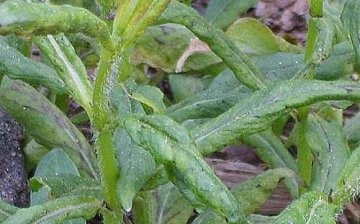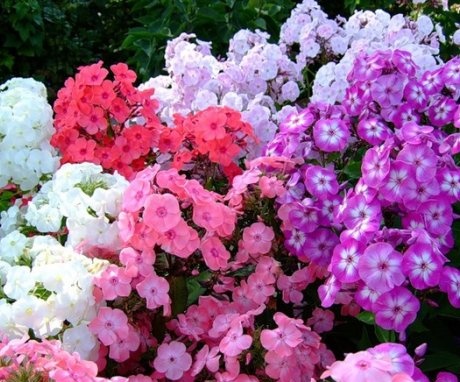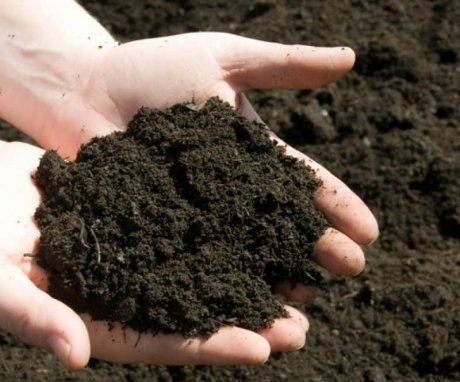Planting phlox in the fall: terms and rules
Phlox - a bright decoration of any flower garden. They are winter-hardy, easy to care for, differ favorably with juicy colors, lush flowering and delicate aroma.
Content:
- The best varieties of phlox for autumn planting
- Preparation of soil and planting material
- Everything you need to know about boarding
- Flower Care Tips
- Possible growing problems
- The use of phlox in garden design
The best varieties of phlox for autumn planting
In order to transplant or plant phlox in the fall, early varieties are best suited, such as:
- Bright Ice is a tall pink phlox with large inflorescences.
- Hesperis is a meter tall plant with a dense purple large inflorescence.
- Childhood (75 cm stem height, salmon-pink flowers, large inflorescences).
- North (70 cm high, large, pure white inflorescence).
- Tenor (large raspberry inflorescence, plant height 70 cm).
- Blue joy (light purple color, plant height 80 cm).
These varieties will be able to bloom by August, and at the end of summer they can be prepared for transplantation. Phloxes are not only annual, but also perennial, and grow in the same place for 5-7 years. But only in the second or third year, the flowers can become smaller and lose their splendor. To prevent this, phloxes need to be rejuvenated: divided and transplanted to another place.
Many gardeners argue that the best time to plant phlox is spring, but the practice of experienced flower growers proves that autumn planting is no less effective and even has some advantages.
Benefits of planting phlox in autumn:
- The first advantage is considered to increase the planting time to one and a half months, while the spring dates are reduced to two weeks, because the plant stems grow quickly and transplanting will be risky.
- The second advantage is getting the most beautiful full-fledged flowering plants in the new spring-summer season, of course, provided that the autumn transplant is correct. And at the end of the phlox flowering season, it is easier to identify the transplanted variety of the shared bush.
The autumn transplantation of phlox assumes strict adherence to the transplantation rules, otherwise you can not wait for abundant flowering in the spring.
Preparation of soil and planting material
For an autumn planting, it is better to use the largest cuttings, they can quickly take root, and they will tolerate the cold more easily. Phlox grown from spring cuttings can also be transplanted in the fall. A good cut should have two thick stems with already hardened skin, should be cut to 20 cm and have large renewal buds at the base. The roots of the plant are shortened to 15 centimeters in length.
If phloxes are transplanted together with a basal earthy clod, then only the top of the plant, which has already faded, can be cut off. You can also leave a couple of healthy leaves, they are still continuing their vital activity and will help the phlox prepare for the cold weather.
Site and soil preparation for planting:
- A week or two before planting, you should prepare a suitable place for this, otherwise the soil will not settle enough. The soil is well cleared of weeds and their roots, possible debris and stones.
- Fertile and loose loam is considered suitable for phlox, its level acidity must be neutral. If the plant sits in heavy clay soil, then it must be diluted with coarse sand, peat, humus or compost. If sandy soil is used for planting, then it is diluted with turf and clay.
- The process of soil preparation ends with its digging and introduction mineral fertilizers with lime.
- You need to dig up the soil for phlox deep enough, since the plant has a powerful root that reaches 30 centimeters deep.
- The planting recess should be wide so that there is enough room for the root to fit freely. Its depth should be such that the root is completely immersed in it, and its top is about 5 cm below the ground level. If there is insufficient distance from the surface, the root may freeze.
- Before planting, the hole is filled with water, and after water has been absorbed, a handful of humus is added to it, ash and 100-150 g of phosphate fertilizers. After that, the cut is immersed in the wet gruel and carefully sprinkled with soil.
- In the autumn planting of the plant, potash and phosphate fertilizers are used, and complex nitrogen-containing agents are applied in the spring. The use of a root growth stimulant, for example, "Kornevin", is very effective.
Phlox can also be grown in sandy soil. To do this, a half-meter hole is dug, the soil is selected, the bottom is covered with clay (15-20 cm), and a sand mixture is poured on top. It needs to be well leveled and tamped. A flower bed can be made 10-20 cm above ground level.
Everything you need to know about boarding
Early to mid-flowering phloxes can be replanted towards the end of summer when the regenerating buds are already formed. If a plant is characterized by a later flowering period, then it is planted in September. So phloxes can take root before the frost begins. If planted later, early frosts can kill the plant.
For safety net, in October-November, amateur gardeners insulate the root system of the plant with sawdust mulch, peat or foliage.
In cold weather, organic mulch will protect the root soil from freezing. A film or roofing material cannot be used as a shelter, they do not allow air to pass through and the root can trample. In the spring, the mulch is removed - without it, the soil will warm up faster.
Flower Care Tips
Phlox should not be planted in lowlands, where water constantly accumulates or stagnates, and in late autumn it freezes and forms an ice crust. Phloxes need to be well looked after, thoroughly removed weeds (preferably by the root), and watered often, especially in the first week after planting. After watering, you need to loosen the soil. Fertilize the flower as needed, pick off dried and sick leaves.
You need to water the plant after lunch, or better even in the evening, then it is sharply nailed in growth.
It is better to plant a flower in cloudy weather or in the evening, it will not "get sick" so much. The plant does not like planting density, it becomes cramped over time, flowering becomes scarce or stops altogether.
The flower does not plant in the shade under trees and on the north side, as it loves warmth and light. Tall varieties should be placed in a place protected from frequent winds. Phloxes love the sun; on the sunny side, their inflorescences will be lush and thick. Of course, flowers will grow in shaded places, but they will bloom poorly and will quickly move away.
Possible growing problems
Special problems when growing phlox does not arise, but still, like any plants, they can be susceptible to some diseases, such as:
- rattle (light spots on the leaves), and some varieties are even latent (virus carriers)
- wrinkling (tobacco virus) - the leaves become covered with necrotic spots, curl, dry and the plant dies
- ring spot
- threadiness of leaves
Control methods:
- Plants affected by diseases must be discarded immediately. Cuttings from a diseased bush are not taken. Infected bushes are removed.
- If soil contamination is detected, the soil is treated with metaphos (0.2%) before planting.
Do not be afraid that the plant has been struck by a disease; to combat many sores, there are specially designed preparations for a certain type of plant. They are sold in almost all flower shops. The main thing is to correctly determine the type of disease.
The use of phlox in garden design
Phlox is very often used by many landscape designers for their flower garden compositions. It is a very beautiful, vibrant and simply versatile flower that can be combined with many flowering and non-flowering plants. They are planted as an independent plant near a house, gate or hedge, their juicy colors alternate and are placed along the avenues.
Phloxes look very original inside a round flower bed, especially tall varieties, and lower varieties are planted at the edges.
The most popular for achieving design ideas are subulate, spread apart and paniculate phlox:
- Paniculate varieties are rich in their color palette, the number and size of inflorescences, as well as the height of the bush. They have a large tint range, and there are also monochrome and spotted, as well as interspersed and stripes. They do not require an annual transplant and can stay in the same place for up to 7 years.
- The subulate phlox varieties are distinguished by a creeping stem, which is covered with sharp leaves and is simply strewn with small inflorescences. Their petals are blue, white, pink, both monochromatic and with all kinds of strokes.
- The spread-out phlox grows up to half a meter, on its graceful stem there are inflorescences that resemble the wings of butterflies, they are of different shades and with a pleasant delicate aroma, which intensifies in the evening.
Phlox have more than three hundred varieties, the choice is very large and correctly assessing the dignity of the flower, its beauty and aroma, you can choose the best varieties for your personal plot. Of course, for the successful cultivation of a plant, it is necessary to correctly take into account the climatic conditions, the peculiarity of the soil and the location of the site.
More information can be found in the video:






















